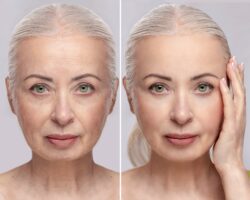
Ponytail Facelift – A Complete Guide
Facelifts have become one of the go-to cosmetic procedures for individuals looking to restore their youthful appearance and address the signs of aging. Among the various facelift options available, the “ponytail facelift” has been gaining popularity, especially for those seeking a less invasive procedure with a quicker recovery time. Suppose you’ve been curious about this trending procedure. This comprehensive guide will explore everything you need to know about the ponytail facelift, its benefits, costs, recovery, and how it compares to other facelift options.
What is a Ponytail Facelift?
The ponytail facelift is a term that refers to a minimally invasive version of a facelift. It’s often called a “weekend facelift” or a “mini facelift” because it is designed to rejuvenate the lower face, particularly the jawline, jowls, and mid-face, with minimal downtime and subtle results.
While it’s called a “ponytail” facelift, this term is not a medical one—it’s more of a marketing term that reflects the idea that patients can wear their hair in a ponytail right after surgery due to hidden incisions and less swelling. Additionally, the facelift results mimic the taut, lifted look you might get from pulling your hair into a high, tight ponytail.

How Much Does a Ponytail Facelift Cost?
On average, a ponytail facelift costs between $10,000 and $15,000, but the price can vary depending on several factors, such as the surgeon’s experience, location of the procedure, and the extent of surgery.
Factors that Impact the Cost of Ponytail Facelift
- Surgeon’s Expertise: More experienced surgeons or those with a high level of expertise may charge more.
- Location: The cost can differ based on where you are located. For instance, major metropolitan areas may have higher fees than smaller towns.
- Additional Procedures: Some individuals choose to combine the ponytail facelift with other cosmetic procedures such as eyelid surgery or brow lifts, which can add to the overall cost.
- Facility Fees and Anesthesia: These fees are also included in the overall cost of the surgery.
While the ponytail facelift is generally less expensive than a traditional facelift, you should still factor in all potential costs when considering the procedure.
What Are the Benefits of a Ponytail Facelift?
A ponytail facelift can be an excellent option for those seeking facial rejuvenation without undergoing extensive surgery. Here are some benefits of the procedure:
1. Less Invasive Surgery
A ponytail facelift is a minimally invasive procedure. It usually involves smaller incisions, which are typically placed around the ears. This means less cutting and less trauma to the skin, leading to a shorter recovery time compared to traditional facelifts.
2. Minimal Recovery Time
One of the major appeals of a ponytail facelift is the shorter recovery period. Unlike traditional facelifts that may require weeks of downtime, many patients report returning to their normal routines within a few days to a week after the procedure.
3. Targeted Results
The ponytail facelift focuses on the lower half of the face—primarily the mid-face, jowls, and jawline—without addressing the neck. This makes it an ideal option for those who only need minor adjustments rather than a full facial rejuvenation.
4. Subtle, Natural-Looking Results
The ponytail facelift can deliver natural-looking results. The procedure helps lift and tighten sagging skin, giving you a refreshed, youthful appearance without the “pulled” look that can sometimes accompany more invasive facelifts.

How Is a Ponytail Facelift Different from Other Facelift Options?
There are several types of facelifts available, and the ponytail facelift is just one of them. Below, we’ll compare the ponytail facelift with other popular options, including the traditional facelift and the mini facelift.
Ponytail Facelift vs. Traditional Facelift
- Invasiveness: Traditional facelifts are more invasive and involve longer incisions. These incisions usually extend from the temples, around the ears, and down the neck. In contrast, a ponytail facelift involves smaller incisions around the ears, making it a less invasive procedure.
- Recovery Time: The recovery time for a traditional facelift can be several weeks, while a ponytail facelift typically offers a quicker recovery of about 1–2 weeks.
- Results: A traditional facelift provides more dramatic results, addressing the entire face and neck, while a ponytail facelift is focused on the lower two-thirds of the face. If you’re looking for a more significant transformation, a traditional facelift may be the better choice.
Ponytail Facelift vs. Mini Facelift
- Scope: The mini facelift, like the ponytail facelift, is also a less invasive procedure, but it may focus on fewer areas. It targets the lower face and jawline but does not provide the same overall rejuvenation that a ponytail facelift does.
- Cost: Both procedures tend to be less expensive than a full facelift, but the mini facelift can be slightly more affordable in some cases.
- Recovery: The recovery time for both the mini facelift and ponytail facelift is relatively short compared to a traditional facelift, making them suitable options for individuals seeking a quick refresh.
Ponytail Facelift vs. Extended Deep Plane Facelift
- Invasiveness: The extended deep plane facelift is the most invasive of the options discussed here. It lifts deeper tissues and addresses the neck, providing a more comprehensive rejuvenation of the entire face and neck. A ponytail facelift only targets the lower face.
- Longevity: The deep plane facelift offers longer-lasting results than the ponytail facelift due to its more invasive nature and thorough rejuvenation.
- Recovery: Because the deep plane facelift is more invasive, the recovery period is longer than that of the ponytail facelift.
What to Expect Before and After a Ponytail Facelift
Before the Procedure
Before your ponytail facelift, you’ll have a consultation with a surgeon who will assess your facial structure and discuss your goals. During this consultation, your surgeon will explain the procedure, answer any questions, and help you set realistic expectations.
- Pre-operative Instructions: You may be asked to avoid certain medications, such as blood thinners, before the surgery. You’ll also be advised to avoid smoking, as it can interfere with the healing process.
After the Procedure
After your ponytail facelift, most patients experience minimal swelling and bruising. You will be given aftercare instructions to ensure the best results. These may include:
- Follow-Up Appointments: These appointments are necessary to check for any complications and ensure the healing process is going smoothly.
- Post-Operative Care: You may need to sleep with your head elevated and avoid strenuous physical activity for a short period after the procedure.
- Scar Care: The incisions are typically hidden around the ears and tend to fade over time. Proper scar care can help minimize visibility.

How Long Do the Results Last?
While the results of a ponytail facelift are not as long-lasting as a traditional facelift or deep plane facelift, they still provide noticeable improvements for several years. The results depend on various factors, including age, skin quality, and the specific procedure performed. Most people enjoy refreshed, youthful features for around 5–10 years before considering additional procedures.
Is a Ponytail Facelift Right for You?
A ponytail facelift is an excellent option for individuals who want subtle rejuvenation with minimal downtime. It’s particularly suited for those with early to moderate signs of aging, such as mild sagging or fine lines. However, if you’re looking for more dramatic, long-lasting results or need more comprehensive facial rejuvenation, you may want to consider other facelift options like the traditional facelift or extended deep plane facelift.
FAQs About Ponytail Facelift
1. Is the ponytail facelift suitable for all skin types?
The ponytail facelift is generally suitable for most skin types, but individual factors such as skin elasticity, facial structure, and age can influence the results. It’s important to consult with a board-certified surgeon to determine if this procedure is appropriate for your unique needs.
2. Can a ponytail facelift be combined with other procedures?
Yes, many patients choose to combine a ponytail facelift with other non-surgical or surgical treatments like eyelid surgery, brow lifts, or Botox for more comprehensive results. It’s essential to discuss any combination treatments with your surgeon to ensure compatibility.
3. How long does the ponytail facelift take to perform?
The ponytail facelift is a relatively quick procedure. It usually takes between 1.5 to 3 hours, depending on the extent of the surgery and any additional treatments involved.
4. Can a ponytail facelift be reversed?
Once a ponytail facelift is performed, it cannot be easily reversed. However, the effects of the facelift are subtle, and the procedure is minimally invasive compared to more aggressive facelift surgeries. If you are considering a different approach later, additional procedures can be discussed.
5. What is the age range for people considering a ponytail facelift?
Ponytail facelifts are often ideal for individuals in their 30s to 60s who have mild to moderate signs of aging, such as sagging skin and fine lines. However, people outside this age range may also be candidates, depending on their facial structure and overall health.
6. How noticeable are the scars after a ponytail facelift?
The incisions made during a ponytail facelift are strategically placed around the ears and hairline, making them relatively discreet. With proper care, the scars typically fade and become barely visible over time.
7. Can men get a ponytail facelift?
Yes, the ponytail facelift is suitable for both men and women who want to address facial aging, particularly around the jawline and mid-face. The procedure can be tailored to suit the unique needs of male facial anatomy.
8. Does a ponytail facelift improve the neck area?
No, the ponytail facelift focuses primarily on the lower face, including the jawline and mid-face. If neck rejuvenation is desired, a full facelift or neck lift may be a better option.
9. How do I know if I am a good candidate for a ponytail facelift?
Good candidates for a ponytail facelift are generally in good health and have mild to moderate signs of aging. If you have more significant sagging or wrinkles, you might benefit more from a traditional or deep plane facelift. An initial consultation with a skilled surgeon will help determine whether the ponytail facelift is right for you.
10. What is the difference between a ponytail facelift and a non-surgical facelift?
A non-surgical facelift typically involves injectables like Botox or fillers to reduce wrinkles and add volume to the face. A ponytail facelift, on the other hand, is a surgical procedure that involves tightening and lifting the skin for longer-lasting, more visible results. The ponytail facelift offers more dramatic and permanent changes compared to non-surgical treatments.
Conclusion
The ponytail facelift is a fantastic option for those seeking subtle facial rejuvenation without major surgery or extended downtime. While it may not provide the same dramatic results as more invasive facelifts, it offers a refreshing change with a quick recovery and natural-looking results. By understanding the differences between facelift options and consulting with a skilled surgeon, you can decide which procedure is proper for your aesthetic goals. Whether you opt for a ponytail facelift or another option, you can feel confident in achieving a youthful and refreshed look.
